I've been interested in data acquisition for a while and asked about it a bit ago. I ended up convinced that there is a reason that there are no professional race teams that don't employ data acquisition. They all do, and there are good reasons for it. Whether or not those same reasons carry over to a regular guy autocrossing for fun is the real question. I'm going to try and answer that question in this thread.
I'm planning to document my use of data acquisition in my Mazda2 while autocrossing and hopefully, how I will use it to make me more aware of what the car and I are doing. The plan is to end up faster.
It would be awesome if this thread ended up being about more than me, and that any of you that have, or are doing, this sort of thing could join in with what you've done. I think the average guy can benefit from this stuff. We'll see.
Well, in the first post I screwed up the title. That's not a good sign.
After talking to a few people on and off this board about the systems out there, I decided on the AIM Solo DL. This is a fairly plug and play system out of Italy that is pretty new, only becoming available in the later part of 2011 as far as I can tell. It combines the lap timer functions of the Solo lap timer with the capability to log data either by attaching wires to the CAN system of a car so equipped, or by plugging into the OBD2 port of a car so equipped. What data you can get depends on how you wire it up, and what is available through your car. I bought it from Pegasus racing because they advertise in GRM.
AiM has a list of cars and ECU's that are supported by the Solo DL. The Mazda2 isn't on that list. In fact, the only Mazda products on the list are the Miata and the RX8. A smart man would have contacted AiM to see if it would work with the 2. I'm not a smart man, but I am lucky.
The Solo DL is easy to hook up. Just plug in the wire, plug that into the OBD2 port and you're set. Time to drive around and see what data is collected, right? Don't do that. When I did that Every light on my dash lit up, none of the gagues worked and the odometer didn't even record the distance I drove around the block. Remember where I said I was lucky and not smart? I'm damn lucky I didn't break something. Even the CEL went away after things were unplugged and a few start stop sequences were performed. Time to read the book.
When you get the SoloDL it comes with a CD of software. You need three seperate programs off that CD (PC only, no macs). You need Race Studio 2, which you use to talk to the device, Race Studio analysis, which you use to analyze the data, and GPS manager, which you use to deal with GPS track data. Why three separate programs? Because race car? First you need to plug the Solo DL into the computer and turn it on, then you need to open Race Studio 2, then you need to configure the device so you don't freak out your car and break stuff like I almost did. I switched the ECU that the Solo DL was looking for from the default to Miata in hopes that is would work. It did, sort of. Then I tried RX8 and got even more info. I finally settled on Mazda CAN_J68C. No idea what this means but it gave me the most information coming out of the OBD2 port. Here's a list of the parameters that I get.
Battery Voltage
RPM
Vehicle Speed
Speed of each individual wheel (awesome)
Yaw rate as measured by the on board Mazda sensors
Percentage throttle
Brake pressure
Engine Temperature
Lambda
Fuel Level
I also get the accelerometer data from the unit as well as all of the 10Hz GPS data. There is a bunch of other stuff that the device tries to read but it comes back as all zeroes from the 2. That's ok. I'm getting everything that I need right now and if I really want more I can always try and talk to AiM to get the rest of it. They're probably really interested in helping out a guy in East Texas who autocrosses for fun. Probably.
I've considered it. Something like a Racetech 4-camera set-up with integrated GPS. Then a couple of Opti-Grip displays for tire pressure and temperature.
A few years ago, I met a H-Stock MINI driver who had a lap-top mounted in the car on one of those pedestal-mount-contraptions and all of the DA and cameras fed into it. He'd do a run and then replay it when he got back to paddock. He specifically had cameras mounted so they could see how close the rear wheels got to the cones. It was a really neat set-up but unfortunately he hasn't been to one of our events in awhile so I could grill him about it.
Ian F, you bring up the camera question. The Solo DL has a second wire that plugs into AiM's camera, the SmartyCam and automatically synchronizes data and video. I don't have this for a couple of reasons. First is cost. The Solo DL is $700, the camera is $1000 and all it adds is video. Yes, the Camera alone records some other things, but all of those things are redundant if you have the Solo DL. The second reason is that I don't think there's a lot of utility in a single front facing camera in autocross. A system like you describe with multiple cameras looking at cones would be much better and I might head that way eventually. For now, I think the greatest benefit is me being able to see exactly how much I'm braking, how much throttle I'm using, whether I'm getting wheel spin and all of the other data I can mine.
If anyone important reads this, is there any way you could fix the title so I look a little less like an idiot?
Ok, I can collect a ton of data, now what does it mean? I've driven around the block enough times to drive my wife nuts but I don't think the data I've collected shows much at normal street speeds. I'm autocrossing this Sunday and should have data to analyze and show after that. In the mean time, reading.
Websites:
Lap Faster is awesome. Especially the ebook they have for free, Data Logger Secrets Revealed
Autocross To Win has some good data logging info sprinkled around in it and is in general a great read.
Trailbrake.net is awesome and has more info than I can hope to assemble. Their link section is also better than this post will be.
Books: For books I'm sticking to the list that J Block gave me.
Data Power by Buddy Fey out of print and multi hundreds of dollars expensive. Anybody want to loan me a copy?
Making Sense of Squiggly Lines by Christopher Brown
A Practical Guide To Race Car Data Analysis by Bob Knox (this book should show up in my mailbox today)
Analysis Techniques for Racecar Data Acquisition by Jorge Segers
As I find more useful stuff I'll add to this list. Happy Reading.
Ran my first event collecting data yesterday. I'm working on sifting through it and figuring out the best way to get images from my computer to here so I can show what I see. This post is mostly a test, but it does show real data. This is a plot of speed versus distance, red is my fastest run, blue is my slowest. Unsurprisingly, the run where I went faster, I recorded a shorter time. Lesson learned, to go faster, go faster. I promise, what follows will be more useful, I have to take the kids to the dentist and then get back to working on this.
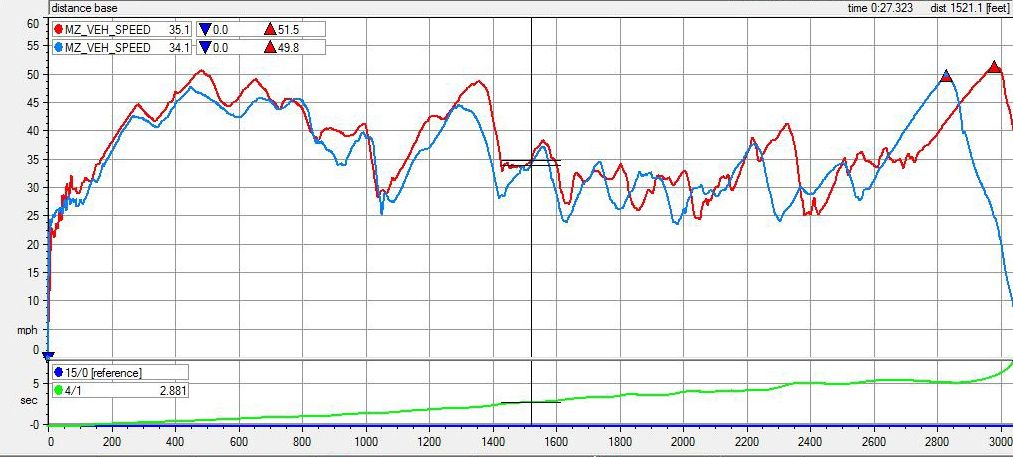
mazdeuce wrote: Unsurprisingly, the run where I went faster, I recorded a shorter time.
It's also interesting, from a driving and line choice standpoint, that you also recorded a shorter distance...
EDIT: I totally have that backward. Which is also interesting.
Hey deuce, Welcome to the wonderful world of data. Very likely your life will never be the same.
Can you add steering? The amount of info skyrockets with that one sensor and the trick you can do with math channels in the racestudio.
J Block wrote: Hey deuce, Welcome to the wonderful world of data. Very likely your life will never be the same. Can you add steering? The amount of info skyrockets with that one sensor and the trick you can do with math channels in the racestudio.
Yea, I'm realizing that steering would open up a lot. I don't know if it's available natively on the Mazda2 and it just isn't reading (the RX8 shows it available) or if I need to add another sensor and how I go about that on the Solo DL. What I really really want is shock position data. After just one event I think every expense it completely justified. This is going to be fun.
More charts!
I'm showing speed again, but this time from individual wheel sensors which is pretty sweet. I'm doing the fronts and the rears separate to show the different things that are happening at the different ends of the car. Fronts first:

First things first, right at the beginning the left front is going all spinny and the right front is just hanging out. The start of the course was a launch right into a tight left turn, so yea, that's that. After that, you see wheel spin under acceleration right before 1200 feet, at 1500 feet, and a big one at 2100 feet. It probably occurs elsewhere too. The mighty mazda2 is spinning Star Specs under acceleration. Awesome. Well, awesome and something to work on. I'm not sure that I could feel any of this by the way, except for the beginning. Maybe once on the course I would have told you that I had wheel spin, but not as much as the data says.
On to the rear of the car and what the wheel speed can show us.
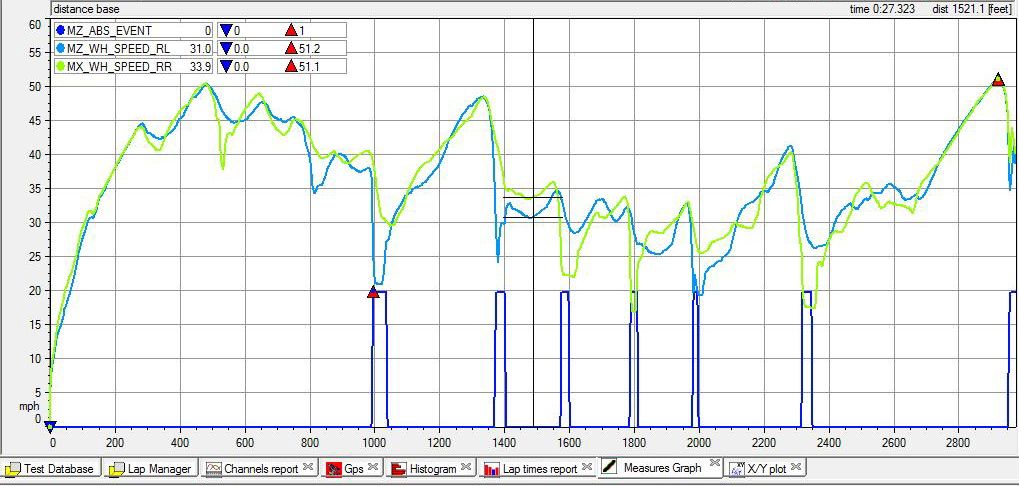
As with the front wheels, the rears should go pretty much the same speed with the exception of corners. When they're not, something is up. In this case, we don't have wheel spin, we have wheels stoppage. You can see that at 1000 feet 1400 feet, just before 1600 feet and so on. Rear wheel in the air? I added another channel to this plot to help try and figure things out, ABS event. When it's all said and done, I'm not sure if I'm locking the very light rear wheel under braking, or if I'm picking it up and the ABS is responding to that. It probably doesn't matter in the end as I appear to have enough rear roll stiffness that the inside rear wheel is light enough to not be participating in traction.
Is it worth doing a math channel comparing the front wheel speeds? Assuming the outer wheel is at or near 0% wheelspin, up to 5-10% faster on the inside wheel would actually be within the scope of where maximum acceleration is found, isn't it? (Minus how much slower the inside should be turning due to differences in wheel path?)
I don't know for the star specs specifically, nor whether all bets are off when the wheel's being pulled light by roll, but just as with slip angle, there's a percentage of slip under acceleration and braking which is ideal for each tire type, right? Or does it vary with vertical loading?
In reply to ransom:
All good questions that I need to figure out, and those math channels are going to be my project for this evening. Right now I'm sharing the computer with my kids for school work and after school computer time. Daddy needing to analyze data isn't a legitimate excuse to hog the computer.
In reply to mazdeuce:
Oh it is justified![]() With the addition of the steering sensor you can identify understeer/oversteer slip angle in the tires and and even your line to identify early apex, late apex etc. This is why data is the engineer's friend and the crew chief call the logger the lie detector
With the addition of the steering sensor you can identify understeer/oversteer slip angle in the tires and and even your line to identify early apex, late apex etc. This is why data is the engineer's friend and the crew chief call the logger the lie detector![]()
Two more plots for tonight. The first is Calculated Wheel slip as presented in A Practical Guide to Race Car Data Analysis. The idea is that you compare the speed of a wheel to the average of the two wheels on the opposite end of the car. If it's above zero then you are spinning under acceleration, if you're below zero then you're locking under braking. It all sounds good, but here's the plot:
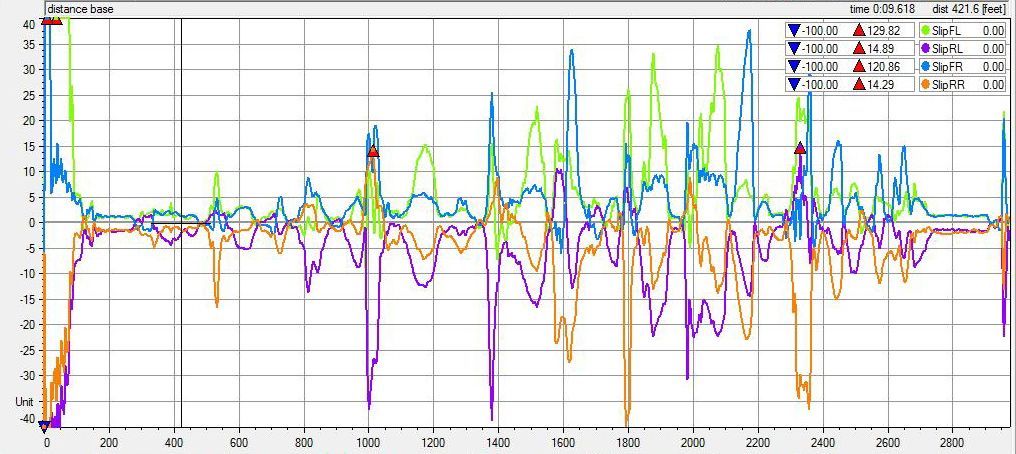
It looks like there's a lot of cross talk between the front and the rear. When I have slip, I have quite high slip, above 30% and even way above 40% when I'm doing my super burn out start. That seems to be messing with the calculation on my other end making things quite hard to interpret. Maybe J Block can let me know what's going on.
The second plot is a scatter plot of lateral acceleration vs. longitudinal acceleration:
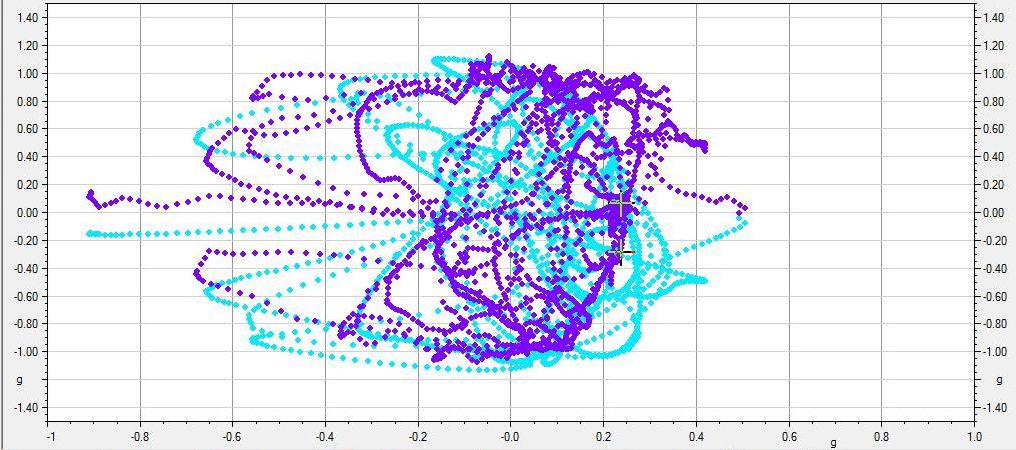 In my data I get one longitudinal acceleration, what's calculated from position and speed. For lateral, I get two readings, one that's calculated, and one that's read from the car's on board sensors. In the plot the reading from the car is in purple and the calculated reading from the data logger is light blue. The fact that they're different is interesting and is something that I need to figure out. What's also interesting is the fact that the data says that I'm pulling over one G a few times and I'm peaking out at over 1.1 G's in both directions. In Mazda2 with just camber bolts and Star Specs. I'm going to hang out and feel kind of awesome about that until somebody comes along to explain to me why those reading are bad. What I can tell is bad is the exceptionally poorly defined friction circle. In theory, the data should define the boundry of the tire friction circle that we've all read about when reading about race car driving. My data just looks like a sloppy blob of dots. I might be reaching the edges, but I'm not living on them. Damn.
In my data I get one longitudinal acceleration, what's calculated from position and speed. For lateral, I get two readings, one that's calculated, and one that's read from the car's on board sensors. In the plot the reading from the car is in purple and the calculated reading from the data logger is light blue. The fact that they're different is interesting and is something that I need to figure out. What's also interesting is the fact that the data says that I'm pulling over one G a few times and I'm peaking out at over 1.1 G's in both directions. In Mazda2 with just camber bolts and Star Specs. I'm going to hang out and feel kind of awesome about that until somebody comes along to explain to me why those reading are bad. What I can tell is bad is the exceptionally poorly defined friction circle. In theory, the data should define the boundry of the tire friction circle that we've all read about when reading about race car driving. My data just looks like a sloppy blob of dots. I might be reaching the edges, but I'm not living on them. Damn.
The traqmates in the car, so I use it at autox too. After a frustrating year of fooling with it (had an intermittently bad cable, replaced under warranty) I'm starting to get the hang of what it's trying to tell me. Wish I had ORBD II, it would make the hookup easier.
Can you plot just wheel speed? Is the slip from your math or the car?
On your G-G plot can you tutn it clockwise 90 deg. Make long G Y axix and lat G x axis. I can't tell if there is a clibration or sign diff between the two signals.
The slip is from my math. The formula is right (or at least what the book says) and makes sense. Sometimes it looks like it should, other times it's confusing. I plotted fronts and rears separately above, but here are all four together.
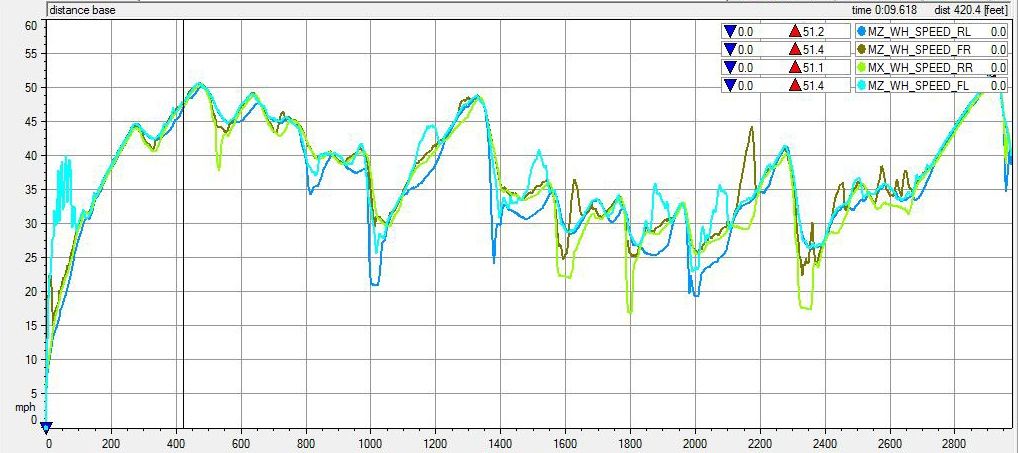
The other channel I was looking at is what's called VEH_SPD_GND. It's a channel that I get out of the car and it looks like the car takes all four wheel sensors (and maybe yaw and acceleration) and tries to figure out what real ground speed is. It's lower than the VEH_SPEED output where I know I have spin anyway. If I can trust it then it will make things easier.
I solved my scatter plot question too. It was a sign issue, I just reversed the sign on one and re-plotted and they matched up fairly well. I haven't figured out how to put two data sets on the X-axis yet. I need to poke around more.

A deep heartfelt thanks for looking at and commenting on what I'm doing here. Without steering angle, is there anything else that I should be looking at right now? This event was with the Houston BMWCCA and the course had some issues. There were 73 drivers and I count 78 DNF's on the results list. Half a dozen pointer cones would have helped the navigation out a lot. Even once you figured out where to go, the flow was pretty terrible. Part is course design, but a big part is the facility which forces them to add kinks and chicanes to corners that would otherwise be too fast on a lot of the course. My next event is with the Houston SCCA and they usually do a really good job designing courses that flow well and are very driveable. I'm hoping I can start to do some corner analysis then.
In reply to car39:
What are you looking at in your data? What are you finding helpful? I have so much to look at that I'm a little overwhelmed. I need to sort things out and figure out what matters for autocross. OBDII isn't always awesome, but for this, it's pretty sweet.
You should come up to a TAMSCC practice day over the summer at Texas A&M. You'd have a ton of opportunities to gather and interpret data.
I should come up and do one of your events no matter what. Do you have a schedule for them? I tried to find it online but failed. Word on the street is that your site is super awesome and I want to drive it. Summer is out for me, I spend the hot part of the year 1400 miles north where it doesn't suck to walk outside the door. No summer fun driving, which is sad, but living on the beach and swimming every day, which is happy.
The club's site is tamscc.org. The site is pretty awesome, yeah, it's an old USAF training base from the 50's that was given to A&M to use for research. Unfortunately their last event of the semester was last Sunday, and they're moving into the summer practice schedule. I'm not sure when they'll have those events posted, though.
I'm a geek. If I started doing this data acquisition thing, I wouldn't see the light of day from about mid-March to mid-November.
You'll need to log in to post.